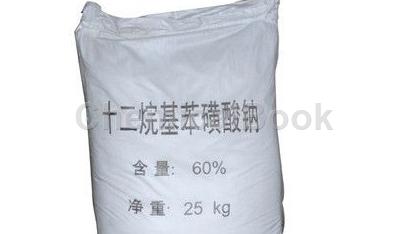Sodium dodecylbenzene sulfonate, SDBS for short, is a white or light yellow powder or flake solid. Difficult to volatilize, easily soluble in water, easy to absorb moisture and agglomerate, dissolve in water to form a translucent solution. It is chemically stable to alkali, dilute acid and hard water, can establish a balanced system with strong acid, and is slightly toxic. It is a commonly used anionic surfactant.
Product Usage
1. Washing effect
Sodium dodecyl benzene sulfonate is neutral, sensitive to water hardness, not easy to oxidize, has strong foaming power, high detergency, easy to compound with various additives, low cost, synthetic process Mature and widely used, it is an excellent anionic surfactant. Sodium dodecyl benzene sulfonate has a significant decontamination effect on particulate dirt, protein dirt and oily dirt. It is especially good at washing particulate dirt on natural fibers. The detergency increases with the increase of washing temperature and is effective on protein. The effect of dirt is higher than that of non-ionic surfactants, and the foam is rich. However, sodium dodecyl benzene sulfonate has two disadvantages. First, it has poor resistance to hard water and its decontamination performance may decrease with the hardness of the water. Therefore, detergents with it as the main active agent must be used with an appropriate amount of chelating agent. Second, it has strong degreasing power and is irritating to the skin when washed by hand. The clothes feel poor after washing, so it is better to use cationic surfactants as softeners for rinsing. In recent years, in order to obtain better comprehensive cleaning effect, sodium dodecyl benzene sulfonate is often used in combination with non-ionic surfactants such as fatty alcohol polyoxyethylene ether (AEO). The main use of sodium dodecylbenzene sulfonate is to prepare various types of liquid, powdery and granular detergents, cleaners and cleaners.

2. Emulsifying and dispersing agent
An emulsifier is a substance that improves the surface tension between various constituent phases in an emulsion to form a uniform and stable dispersion system or emulsion. Emulsifiers are surface-active substances with both hydrophilic and lipophilic groups in their molecules. They gather at the oil/water interface, which can reduce the interfacial tension and the energy required to form an emulsion, thereby increasing the energy of the emulsion. As an anionic surfactant, sodium dodecylbenzene sulfonate has good surface activity and strong hydrophilicity, which can effectively reduce the tension of the oil-water interface and achieve emulsification. Therefore, sodium dodecylbenzene sulfonate is widely used in the preparation of emulsions such as cosmetics, printing and dyeing auxiliaries, and pesticides.
3. Antistatic agent
Any object has its own static charge. This charge can be negative or positive. The accumulation of static charges can affect or even harm life or industrial production. Guide and eliminate the accumulated harmful charges. Chemicals that do not cause inconvenience or harm to production and life are called antistatic agents. Sodium dodecyl benzene sulfonate can make the surface of fabrics, plastics, etc. affinity with moisture. At the same time, the ionic surfactant also has a conductive effect, so it can cause static electricity to leak in time, thereby reducing the danger and inconvenience caused by static electricity
4. Other functions
In addition to the applications in the above aspects, in terms of textile auxiliaries, it is also often used as a refining agent for cotton fabrics, a desizing agent, a leveling agent in dyeing, and a metal degreasing agent in the metal plating process; in papermaking Used as resin dispersant, felt detergent, deinking agent in industry; used as penetrating degreasing agent in leather industry; used as anti-caking agent in fertilizer industry; used as air-entraining agent in cement industry, etc. Use alone or as an ingredient.

 微信扫一扫打赏
微信扫一扫打赏

